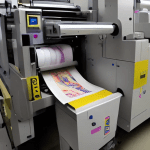Why specifically is flexo printing so effective and economically interesting as a printing process? What are the advantages and disadvantages of flexographic printing?
Flexo printing is more in demand than ever as a printing process. Why is that? There are things in life that are simply good and unbeatable. Often precisely because they are so basic in principle, so simple. A paper clip, for example, or a stamp or the wheel. Of course, there have been and still are countless variations and attempts to make these inventions even better in the course of history. Different, of course, is not necessarily better. However, if you cleverly combine two ingenious inventions, things suddenly look very different – see flexographic printing. Basically, the flexographic printing process is a crossover between a stamp and a wheel, if you will. Simply clever, innovative and groundbreaking too. So, Let’s look at some of the flexographic printing pros and cons.
Advantages of flexographic printing
The main advantage of flexographic printing is its versatility, its range of materials that cannot be processed with other printing processes, or only with a loss of quality or compromise. The range of substrates in flexographic printing extends from cellulose, paper, cardboard and corrugated board to elastic/stretchable films and a wide variety of plastics and aluminum. But flexographic printing has even more to offer …
Printing process
– Fast, universal printing process
– Flexible printing plate production
– High format variety (stepless)
– Continuous printing in webs possible
– Different ink systems can be used
Application/print image
– Enormous variety of materials (substrates)
– Extremely thin materials possible (foils)
– High ink volume transfer possible (solids)
– Halftone printing with good image quality
– Very high register accuracy
– Excellent sharpness of text/digits, QR and EAN codes
– Very low color fluctuations
– Fine color gradients possible
Economic efficiency
– Moderate investment costs
– Low setup costs
– Low waste/material loss in press proofs
– Fast production of large quantities/runs
– High economic efficiency
Ecological footprint
– Environmentally friendly printing process
– Water-based inks can be used
– Low ink emulsions
– High recyclability of printed packaging
And the best thing is: In total, the many advantages accumulate to the maximum, for example on the flexographic printing press in satellite design – keyword efficiency: thanks to centralized impression cylinders, flexographic printing high speeds of up to 800 meters of substrate web per minute are not uncommon. Added to this are one-off cliché costs and fast press makeready. In specialist circles, flexographic printing is regarded as an efficient process for runs of 3,000 meters or more, particularly in the packaging printing sector.
Disadvantages of flexographic printing
Disadvantages of flexographic printing are concentrated in the areas of printing plate production and, in some cases, limited print quality. For example, the production and assembly of the printing plates is comparatively extensive and time-consuming, which is (too) cost-intensive, especially for short runs. Apart from this, compared with conventional offset printing, flexographic printing results, particularly in the high-light range (tonal values of almost 1 percent), are still subject to quality compromises in terms of print brilliance.
These were some of the flexographic printing pros and cons. Nevertheless, flexographic printing experts agree that there is no real alternative to flexographic printing when it comes to mass printing and especially in packaging printing.
Nevertheless, they have identified two or three areas in which flexographic printing should be improved in the future. Among other things, this concerns cooperation in the periphery.
Read in the next article: Flexographic printing in the mirror of time




